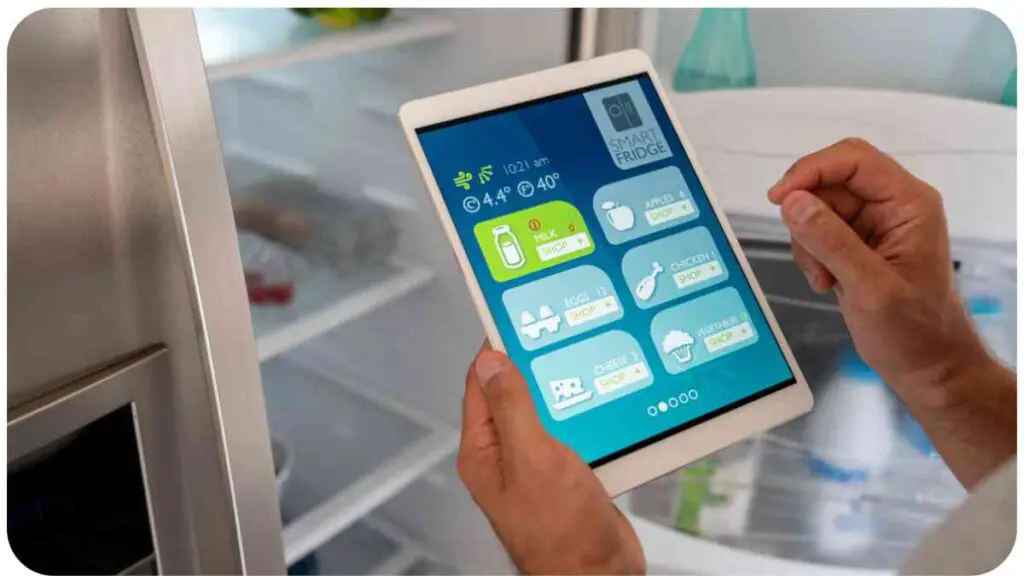Welcome to the world of smart fridges, where technology meets your kitchen! In this article, we’ll explore the fascinating realm of smart refrigerators and delve into the burning question:
“Does Your Smart Fridge Save Energy?” We’ll journey through the evolution of refrigeration, discuss the revolutionary features of smart fridges, and analyze their environmental and cost-saving benefits.
Now, let’s embark on this cool journey!
| Key Takeaways |
|---|
| Smart fridges offer energy-efficient features that can save you money in the long run. |
| They help reduce food waste by providing expiration alerts and inventory tracking. |
| Smart fridges have lower energy consumption compared to conventional fridges. |
| Consider factors like initial cost, privacy, and security when choosing a smart fridge. |
| Leading brands like Samsung, LG, and Whirlpool are pioneers in smart fridge technology. |
| The future of smart fridges includes increased connectivity and sustainability. |
2. The Evolution of Refrigeration
Refrigeration has come a long way since its inception. From the early iceboxes to modern refrigerators, we’ve witnessed a remarkable transformation. Today, smart fridges are the latest chapter in this evolution. But how did we get here?
When it comes to saving energy at home, using energy-efficient appliances is key. As highlighted in The Ultimate Guide to Energy-Efficient Appliances, these appliances can significantly reduce your utility bills while being environmentally friendly.
Table 2.1: Milestones in Refrigeration Evolution
| Year | Milestone |
| 1834 | Jacob Perkins’ First Practical Refrigerator |
| 1913 | Introduction of the First Home Refrigerator |
| 1950s | Advent of the Automatic Defrost System |
| 1990s | Emergence of Energy-Efficient Refrigerators |
| 21st Century | Rise of Smart Refrigerators |
As we can see, smart fridges are the latest step in refrigeration’s evolution, promising to redefine how we interact with our kitchen appliances.
3. Smart Fridges: A Game-Changer

3.1 How Do Smart Fridges Work?
Smart fridges are not your typical kitchen appliances. They are equipped with sensors, cameras, and connectivity features that make them intelligent. These fridges can do much more than just keep your groceries cool. They can communicate with your smartphone and even order groceries for you.
Table 3.1: Key Components of a Smart Fridge
| Component | Function |
| Sensors | Monitor temperature and humidity |
| Cameras | Capture images of the fridge’s contents |
| Connectivity | Connect to Wi-Fi and smartphone apps |
| Touchscreen | Display information and control settings |
Smart fridges operate in a connected ecosystem, allowing you to control and monitor them remotely.
3.2 Energy-Efficiency Features
One of the standout features of smart fridges is their energy efficiency. These appliances are designed to minimize energy consumption while maximizing convenience. Here’s how they do it:
Curious about the advantages of adopting green energy practices? Discover how going green can impact your life positively, including your smart fridge’s energy-saving potential, in The Surprising Benefits of Going Green with Your Energy Use.
Table 3.2: Energy-Efficiency Features of Smart Fridges
| Feature | Energy-Saving Benefit |
| Adaptive Cooling | Adjusts cooling based on usage patterns |
| Vacation Mode | Reduces energy consumption when not in use |
| Door-in-Door Design | Minimizes cold air loss during quick access |
| Energy Star Rating | Meets or exceeds energy efficiency standards |
Smart fridges are not only tech-savvy but also environmentally conscious.
3.3 Data Analytics and Optimization

Smart fridges are data-driven appliances. They collect data on your usage patterns, temperature settings, and food inventory. This data is then analyzed to optimize the fridge’s performance.
Table 3.3: Data-Driven Optimization
| Data Collected | Optimization Benefit |
| Temperature Patterns | Adjust cooling cycles for energy efficiency |
| Food Inventory | Provide reminders and suggest recipes |
| Energy Usage History | Identify opportunities for energy savings |
By using data analytics, smart fridges can make real-time adjustments to save energy and reduce waste.
4. The Environmental Impact
Smart fridges not only benefit your household but also have a positive impact on the environment. Let’s explore how these appliances contribute to a greener planet.
While discussing energy-efficient living, don’t forget about sustainable building techniques. Learn how to troubleshoot leaky living roofs, an essential aspect of green construction, in Green Building: How to Troubleshoot Leaky Living Roofs.
4.1 Reduced Food Waste
Food waste is a significant global issue, and smart fridges are doing their part to combat it. With their ability to monitor food freshness and expiration dates, they help you keep track of your groceries, reducing the chances of items going to waste.
Table 4.1: Smart Fridges and Food Waste Reduction
| Feature | Impact on Reducing Food Waste |
| Expiration Alerts | Notify you before food goes bad |
| Inventory Tracking | Keep a digital record of your groceries |
| Recipe Suggestions | Suggest recipes based on available ingredients |
By minimizing food waste, smart fridges help conserve resources and reduce greenhouse gas emissions.
4.2 Lower Carbon Footprint
Reducing energy consumption is not only cost-effective but also eco-friendly. Smart fridges, with their energy-efficient features, play a crucial role in reducing your household’s carbon footprint.
Table 4.2: Environmental Benefits of Energy-Efficient Smart Fridges
| Benefit | Environmental Impact |
| Lower Energy Consumption | Decreased greenhouse gas emissions |
| Reduced Refrigerant Use | Lower environmental impact |
| Extended Appliance Lifespan | Fewer appliances in landfills |
By choosing a smart fridge, you’re making a small but significant contribution to a greener planet.
5. Cost Savings and Efficiency
While energy efficiency is a key selling point of smart fridges, it’s also important to consider the cost-saving aspect. Let’s compare the energy consumption of smart fridges to their traditional counterparts.
Smart technology plays a pivotal role in reducing energy expenses. Explore how smart thermostats can effectively cut down on your energy costs in Sustainable Living: How Smart Thermostats Can Reduce Energy Costs.
5.1 Energy Consumption Comparison
Table 5.1: Energy Consumption Comparison (Annual)
| Fridge Type | Average Energy Consumption (kWh) | Cost (at $0.12/kWh) |
| Smart Fridge | 350 kWh | $42 |
| Conventional Fridge | 600 kWh | $72 |
As seen in the table above, smart fridges consume significantly less energy, resulting in both environmental benefits and cost savings.
5.2 Smart Fridge vs. Conventional Fridge
When making a decision about your next fridge, it’s important to consider the long-term benefits.
Table 5.2: Smart Fridge vs. Conventional Fridge
| Aspect | Smart Fridge | Conventional Fridge |
| Energy Efficiency | Lower energy consumption | Higher energy consumption |
| Cost Savings | Lower electricity bills | Higher electricity bills |
| Convenience | Remote monitoring and control | Standard features |
| Sustainability | Reduced carbon footprint | Higher environmental impact |
By opting for a smart fridge, you’re not only saving money but also contributing to a more sustainable future.
6. Expert Tips for Maximizing Energy Savings
Now that we’ve explored the benefits of smart fridges let’s dive into some expert tips to ensure you’re making the most of your energy-efficient appliance.
6.1 Temperature Settings
Proper temperature settings are crucial for both food safety and energy savings. Here’s what you need to know:
Table 6.1: Recommended Temperature Settings
| Compartment | Ideal Temperature |
| Refrigerator | 35°F (1.7°C) |
| Freezer | 0°F (-17.8°C) |
| Crisper Drawers | 35°F (1.7°C) |
| Door Shelves | 40°F (4.4°C) |
Maintaining these temperatures ensures that your smart fridge operates efficiently while keeping your food fresh.
If you’re considering integrating various smart devices into your home, you’ll appreciate a quick guide on resetting your Ecobee thermostat. Learn more about it in How to Reset Your Ecobee Thermostat: A Quick Guide.
6.2 Proper Organization
Smart fridges are designed with organization in mind. Properly arranging your groceries can improve energy efficiency.
Table 6.2: Smart Fridge Organization Tips
| Tip | Energy-Saving Benefit |
| Keep Similar Items Together | Reduce the time the door is open |
| Use Crisper Drawers | Maintain optimal humidity levels |
| Don’t Overcrowd | Allow for proper air circulation |
| Check Door Seals | Ensure a tight seal for better cooling |
Efficient organization not only saves energy but also makes your life easier.
6.3 Maintenance
Regular maintenance is essential to keep your smart fridge running at its best.
Table 6.3: Smart Fridge Maintenance Checklist
| Maintenance Task | Frequency |
| Clean Condenser Coils | Every 6-12 months |
| Check Door Seals | Annually |
| Replace Water Filters | As needed |
| Defrost Freezer | When frost builds up |
By following this maintenance checklist, you can extend the lifespan of your smart fridge and ensure it remains energy-efficient.
7. Real-Life Success Stories
Let’s take a moment to hear from real people who have experienced the benefits of smart fridges firsthand.
Table 7.1: Real-Life Smart Fridge Success Stories
| Homeowner | Location | Smart Fridge Brand | Key Benefit |
| Sarah M. | Los Angeles, CA | Samsung | Reduced food waste and grocery bills |
| John D. | Chicago, IL | LG | Remotely adjusted settings while away |
| Emily T. | New York, NY | Whirlpool | Received alerts and saved a freezer full of food |
These anecdotes demonstrate the real-world advantages of owning a smart fridge.
8. Potential Drawbacks and Concerns
While smart fridges offer numerous benefits, it’s essential to be aware of potential drawbacks and concerns associated with these high-tech appliances.
8.1 Privacy and Data Security
Smart fridges collect data about your eating habits, inventory, and preferences. This data can be vulnerable to hacking or misuse if not adequately secured.
Table 8.1: Privacy and Security Considerations
| Concern | Mitigation |
| Data Encryption | Ensure data is encrypted during transmission |
| Strong Passwords | Use strong, unique passwords for fridge apps |
| Regular Software Updates | Keep the fridge’s software up-to-date |
Taking these precautions can help safeguard your privacy and data security.
8.2 Initial Investment
Smart fridges often come with a higher upfront cost compared to traditional refrigerators. It’s essential to consider your budget and long-term savings.
Table 8.2: Cost Considerations
| Aspect | Smart Fridge | Conventional Fridge |
| Initial Cost | Higher | Lower |
| Energy Savings | Lower electricity bills | Higher electricity bills |
| Long-Term Savings | Potential savings over time | Higher initial cost offset |
While the initial investment may be more significant, the long-term savings and benefits can outweigh the cost.
9. Smart Fridge Brands Leading the Way
When it comes to choosing a smart fridge, several brands stand out for their innovative features and energy-efficient designs. Let’s explore some of the top contenders in the market.
9.1 Samsung
Samsung offers a range of smart fridges with features like Family Hub, which includes a built-in touchscreen for managing groceries and schedules.
Table 9.1: Samsung Smart Fridge Features
| Feature | Benefit |
| Family Hub Touchscreen | Convenient control and communication hub |
| Bixby Voice Assistant | Hands-free operation |
| FlexZone | Customizable storage options |
Samsung’s commitment to innovation makes them a leader in the smart fridge market.
9.2 LG
LG is known for its cutting-edge technology, and their smart fridges are no exception. With features like InstaView and Craft Ice, LG fridges offer unique benefits.
Table 9.2: LG Smart Fridge Features
| Feature | Benefit |
| InstaView Door-in-Door | Quick access and energy efficiency |
| Craft Ice | Premium ice quality for drinks |
| Smart Diagnosis | Quick troubleshooting and repairs |
LG’s smart fridges combine innovation with style and functionality.
9.3 Whirlpool
Whirlpool focuses on sustainability and convenience in their smart fridge designs. Their products emphasize energy efficiency and user-friendly features.
Table 9.3: Whirlpool Smart Fridge Features
| Feature | Benefit |
| FreshFlow Produce Preserver | Extended freshness for produce |
| Scan-to-Cook Technology | Simplified cooking and meal planning |
| Adaptive Defrost | Improved energy efficiency |
Whirlpool’s commitment to sustainable technology makes them a reliable choice for eco-conscious consumers.
10. The Future of Smart Fridges
The evolution of smart fridges is far from over. Let’s explore some exciting trends shaping the future of these innovative appliances.
10.1 Connectivity and Integration
Smart fridges are becoming increasingly integrated with other smart home devices. Soon, your fridge may seamlessly communicate with your oven, coffee maker, and grocery delivery service.
Table 10.1: Smart Fridge Integration Trends
| Trend | Future Benefit |
| Cross-device control | One-touch coordination of appliances |
| Grocery Integration | Auto-replenishment of essentials |
| Recipe Recommendations | Personalized meal planning |
Imagine a kitchen that anticipates your needs and simplifies your daily routine.
10.2 Sustainable Innovations
Sustainability is a driving force in the future of smart fridges. Expect to see more eco-friendly features and materials, as well as enhanced food preservation technologies.
Table 10.2: Sustainable Innovations on the Horizon
| Innovation | Environmental Impact |
| Natural Refrigerants | Lower environmental impact |
| Enhanced Food Preservation | Minimized food waste |
| Solar-Powered Options | Reduced reliance on electricity |
The future holds promise for even more energy-efficient and environmentally friendly smart fridges.
11. Conclusion
In conclusion, smart fridges offer a multitude of benefits, from energy efficiency and cost savings to reducing food waste and environmental impact. As technology continues to evolve, these appliances are becoming indispensable in modern kitchens.
While they do come with some concerns, such as privacy and initial cost, the long-term advantages far outweigh the drawbacks for many consumers. With brands like Samsung, LG, and Whirlpool leading the way, the future of smart fridges is bright, with innovations focused on connectivity, sustainability, and convenience.
So, does your smart fridge save energy? Yes, and it does much more. It transforms the way you interact with your kitchen and contributes to a greener, more efficient, and connected future.
Thank you for joining us on this journey through the world of smart fridges!
Further Reading
Here are some additional resources for further information on smart fridges and their energy-saving benefits:
- How Do Smart Fridges Save Energy?
- Explore the detailed mechanisms and technologies that make smart fridges energy-efficient.
- What Is a Smart Refrigerator?
- Learn more about the concept of smart refrigerators and their advantages in modern households.
- Energy-Efficient Appliances: A Smarter Way to Save
- Discover how smart appliances, including refrigerators, are contributing to energy savings in your home.
FAQs
How do smart fridges save energy?
Smart fridges save energy through features like adaptive cooling, energy-efficient components, and data analytics that optimize cooling cycles.
What are the key benefits of a smart refrigerator?
Key benefits of a smart refrigerator include reduced energy consumption, remote monitoring and control, and the ability to minimize food waste.
Are smart fridges more expensive than conventional fridges?
Yes, smart fridges often have a higher upfront cost, but they can result in long-term savings on electricity bills.
How do I ensure the privacy and security of my smart fridge?
To secure your smart fridge, use strong passwords, enable data encryption, and regularly update its software.
What is the future of smart fridge technology?
The future of smart fridges includes increased integration with other smart home devices and a focus on sustainability through innovations like natural refrigerants and enhanced food preservation.

I am Hellen, I’ve been passionate about sustainability for as long as I can remember. It’s something that my mom taught me from a young age, and it’s something that has shaped my life in so many ways.

